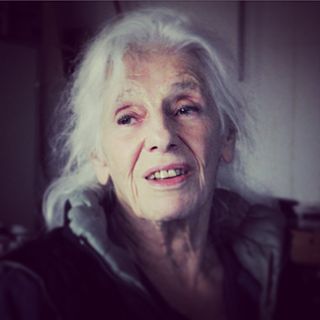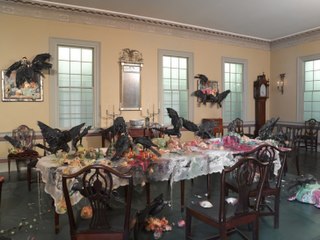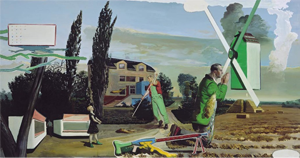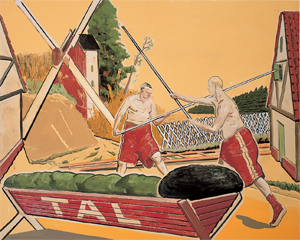
Cubism is an early-20th-century avant-garde art movement begun in Paris that revolutionized painting and the visual arts, and influenced artistic innovations in music, ballet, literature, and architecture. Cubist subjects are analyzed, broken up, and reassembled in an abstract form—instead of depicting objects from a single perspective, the artist depicts the subject from multiple perspectives to represent the subject in a greater context. Cubism has been considered the most influential art movement of the 20th century. The term cubism is broadly associated with a variety of artworks produced in Paris or near Paris (Puteaux) during the 1910s and throughout the 1920s.

Pointillism is a technique of painting in which small, distinct dots of color are applied in patterns to form an image.

Amy Sillman is a New York-based visual artist, known for process-based paintings that move between abstraction and figuration, and engage nontraditional media including animation, zines and installation. Her work draws upon art historical tropes, particularly postwar American gestural painting, as both influences and foils; she engages feminist critiques of the discourses of mastery, genius and power in order to introduce qualities such as humor, awkwardness, self-deprecation, affect and doubt into her practice. Profiles in The New York Times, ARTnews, Frieze, and Interview, characterize Sillman as championing "the relevance of painting" and "a reinvigorated mode of abstraction reclaiming the potency of active brushwork and visible gestures." Critic Phyllis Tuchman described Sillman as "an inventive abstractionist" whose "messy, multivalent, lively" art "reframes long-held notions regarding the look and emotional character of abstraction."
Arthur Green was one of the original Hairy Who members from Chicago, a group of students from the School of the Art Institute of Chicago who exhibited together in the 1960s and 1970s and made representational art with a slight surrealist touch. He was also a member of the University of Waterloo's faculty for over 30 years. His painting style mixes pop-art motifs with surrealist tendencies. His upbringing in Chicago and its vicinity may have influenced him, from the accessibility of the Art Institute of Chicago to the architecture of Louis Sullivan, but he also may have been influenced by advertisements from the 1940s and 1950s that had undertones of sexuality. His paintings drew from American popular imagery, but complicated it, often using the full spectrum of vibrant colors and combining trompe l'oeil effects to play with the viewer's sense of balance.
Twentieth-century art—and what it became as modern art—began with modernism in the late nineteenth century.

Josephine Gail Baer is an American painter associated with minimalist art. She began exhibiting her work at the Fischbach Gallery, New York, and other venues for contemporary art in the mid-1960s. In the mid-1970s, she turned away from non-objective painting. Since then, Baer has fused images, symbols, words, and phrases in a non-narrative manner, a mode of expression she once termed "radical figuration." She lives and works in Amsterdam, Netherlands.

The Swimming Hole is an 1884–85 painting by the American artist Thomas Eakins (1844–1916), Goodrich catalog #190, in the collection of the Amon Carter Museum of American Art in Fort Worth, Texas. Executed in oil on canvas, it depicts six men swimming naked in a lake, and is considered a masterpiece of American painting. According to art historian Doreen Bolger it is "perhaps Eakins' most accomplished rendition of the nude figure", and has been called "the most finely designed of all his outdoor pictures". Since the Renaissance, the human body has been considered both the basis of artists' training and the most challenging subject to depict in art, and the nude was the centerpiece of Eakins' teaching program at the Pennsylvania Academy of the Fine Arts. For Eakins, this picture was an opportunity to display his mastery of the human form.

Fauvism is a style of painting and an art movement that emerged in France at the beginning of the 20th century. It was the style of les Fauves, a group of modern artists whose works emphasized painterly qualities and strong colour over the representational or realistic values retained by Impressionism. While Fauvism as a style began around 1904 and continued beyond 1910, the movement as such lasted only a few years, 1905–1908, and had three exhibitions. The leaders of the movement were André Derain and Henri Matisse.

The Skater is a 1782 oil on canvas portrait of Sir William Grant by the American artist Gilbert Stuart. Painted while Stuart was living in London, it was the work that first brought the artist broad recognition.

Minimalism describes movements in various forms of art and design, especially Visual art and music, where the work is set out to expose the essence, essentials or identity of a subject through eliminating all non-essential forms, features or concepts. As a specific movement in the arts it is identified with developments in post–World War II Western Art, most strongly with American visual arts in the 1960s and early 1970s. Minimalism is often interpreted as a reaction to abstract expressionism and a bridge to postminimal art practices. Prominent artists associated with this movement include Ad Reinhardt, Nassos Daphnis, Tony Smith, Donald Judd, John McCracken, Agnes Martin, Dan Flavin, Robert Morris, Larry Bell, Anne Truitt, Yves Klein and Frank Stella. Artists themselves have sometimes reacted against the label due to the negative implication of the work being simplistic.

Charles I at the Hunt, also known under its French title Le Roi à la chasse, is an oil-on-canvas portrait of Charles I of England by Anthony van Dyck, dated to c. 1635, and now in the Louvre Museum in Paris. It depicts Charles in civilian clothing and standing next to a horse as if resting on a hunt, in a manner described by the Louvre as a "subtle compromise between gentlemanly nonchalance and regal assurance".

Dancer in a Café is an oil painting created in 1912 by the French artist and theorist Jean Metzinger. The work was created while Metzinger and Albert Gleizes, in preparation for the Salon de la Section d'Or, were publishing, Du "Cubisme", the first major defense of the Cubist movement, and it was first displayed at the 1912 Salon d'Automne in Paris. The work proved controversial within the Municipal Council of Paris, causing debate in the Chambre des Députés about the use of public funds to exhibit such 'barbaric' art, with the Cubists being defended by the Socialist deputy Marcel Sembat.

Femme au Chapeau is an oil painting by the French artist and theorist Jean Metzinger, created c. 1906. The work is executed in a highly personal Divisionist style with a marked Proto-Cubist component during the height of Fauvism. Femme au Chapeau exhibits a presentiment of Metzinger's subsequent interest in the faceting of form associated with Cubism. The painting is part of the collection of the Korban Art Foundation.

Woman with a Fan is an oil painting created in 1912 by the French artist and theorist Jean Metzinger (1883–1956). The painting was exhibited at the Salon d'Automne, 1912, Paris, and De Moderne Kunstkring, 1912, Amsterdam. It was also exhibited at the Musée Rath, Geneva, Exposition de cubistes français et d'un groupe d'artistes indépendants, 3–15 June 1913. A 1912 photograph of Femme à l'Éventail hanging on a wall inside the Salon Bourgeois was published in The Sun, 10 November 1912. The same photograph was reproduced in The Literary Digest, 30 November 1912.

Valerie Hegarty is an American painter, sculptor, and installation artist. She is known for irreverent, often critical works that replicate canonical paintings, furnishings, and architectural spaces from American or personal history undergoing various processes of transformation. Hegarty most often portrays her recreations in meticulously realized, trompe l’oeil states of decay, ruin, or physical attack related to their circumstances. Her work examines American historical themes involving colonization, slavery, Manifest Destiny, nationalism, art-historical movements and their ideological tenets, romantic conceptions of nature, and environmental degradation. Sculpture critic Robin Reisenfeld wrote that among other things, Hegarty's art is "informed by 19th-century American landscape painting as an expression of the sublime, as well as by the manufacturing of two-dimensional 'masterworks' to be destroyed in three-dimensional fashion in order to evoke entropic forces of growth and decay."

Portrait of Catharina Brugman is an oil-on-canvas painting by the Dutch Golden Age painter Frans Hals, painted in 1634 and now in a private collection. It is considered a pendant to the portrait of Catharina's husband Tieleman Roosterman.

Reactionary Situation is an oil on canvas painting by the German artist Neo Rauch, from 2002. It is held in a private collection.

Tal is an oil on canvas painting by the German artist Neo Rauch, from 1999. It is held in the Museum de Fundatie, in Zwolle.
David Humphrey is an American painter, art critic, and sculptor associated with the postmodern turn in painting that began in the late 1970s. He is best known for his playful, cartoonish, puzzling paintings, which blend figuration and abstraction and create "allegories" about the medium of painting itself. Humphrey holds a BFA from Maryland Institute College of Art (1977) and a MA from New York University (1980), where he studied with film critic Annette Michelson; he also attended the New York Studio School from 1996 – 1997. He has been the recipient of many awards including the Guggenheim Fellowship in 2002, the Rome Prize in 2008, and the American Academy of Arts and Letters Purchase Award in 2011. He was born in Augsburg Germany and raised in Pittsburgh, Pennsylvania. He lives and works in New York City.

Medrie MacPhee is a Canadian-American painter based in New York City. She works in distinct painting and drawing series that have explored the juncture of abstraction and representation, relationships between architecture, machines, technology and human evolution, and states of flux and transformation. In the 1990s and 2000s, she gained attention for metaphorical paintings of industrial subjects and organic-machine and bio-technological forms. In later work, she explored architectural instability before turning to semiotically dense canvases combining compartments of color and collaged pieces of garments fit together like puzzles, which New York Times critic Roberta Smith described as "powerfully flat, more literal than abstract" with "an adamant, witty physicality."

















